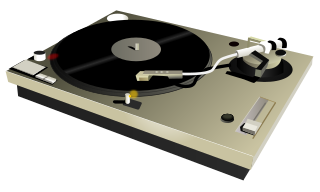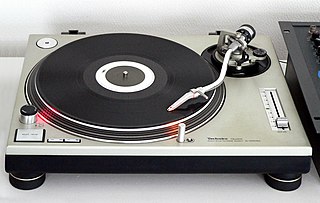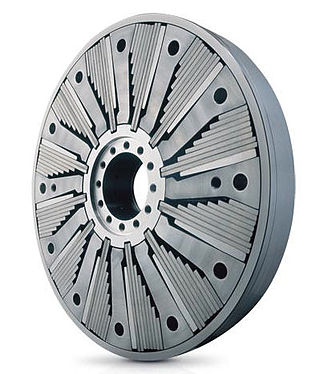
A phonograph, later called a gramophone, and since the 1940s a record player, or more recently a turntable, is a device for the mechanical and analogue reproduction of sound. The sound vibration waveforms are recorded as corresponding physical deviations of a helical or spiral groove engraved, etched, incised, or impressed into the surface of a rotating cylinder or disc, called a record. To recreate the sound, the surface is similarly rotated while a playback stylus traces the groove and is therefore vibrated by it, faintly reproducing the recorded sound. In early acoustic phonographs, the stylus vibrated a diaphragm that produced sound waves coupled to the open air through a flaring horn, or directly to the listener's ears through stethoscope-type earphones.

Scratching, sometimes referred to as scrubbing, is a DJ and turntablist technique of moving a vinyl record back and forth on a turntable to produce percussive or rhythmic sounds. A crossfader on a DJ mixer may be used to fade between two records simultaneously.

A direct-drive turntable is one of the three main phonograph designs currently being produced. The other styles are the belt-drive turntable and the idler-wheel type. Each name is based upon the type of coupling used between the platter of the turntable and the motor.

A synchronous electric motor is an AC electric motor in which, at steady state, the rotation of the shaft is synchronized with the frequency of the supply current; the rotation period is exactly equal to an integer number of AC cycles. Synchronous motors use electromagnets as the stator of the motor which create a magnetic field that rotates in time with the oscillations of the current. The rotor with permanent magnets or electromagnets turns in step with the stator field at the same rate and as a result, provides the second synchronized rotating magnet field. Doubly fed synchronous motors use independently-excited multiphase AC electromagnets for both rotor and stator.

Technics SL-1200 is a series of direct-drive turntables originally manufactured from October 1972 until 2010, and resumed in 2016, by Matsushita Electric under the brand name of Technics. S means "Stereo", L means "Player". Originally released as a high fidelity consumer record player, it quickly became adopted among radio and disco club disc jockeys. The direct drive, high torque motor design made it suitable for push-button cueing for selecting tracks on radio broadcasts and in dance clubs. Besides these features, it also had pitch control, which allowed the user to change the turning speed of the record gradually from -8% to +8%. This feature was specifically interesting for DJs who were mixing two or more records, especially in dance clubs.
Torsional vibration is the angular vibration of an object - commonly a shaft - along its axis of rotation. Torsional vibration is often a concern in power transmission systems using rotating shafts or couplings, where it can cause failures if not controlled. A second effect of torsional vibrations applies to passenger cars. Torsional vibrations can lead to seat vibrations or noise at certain speeds. Both reduce the comfort.
Roksan is a British manufacturer of high fidelity audio products for domestic use, based in Rayleigh, Essex. It is best known for its influential and innovative design for hi-fi equipment, and in particular its Xerxes platform for playing LP records.
A rumble is a continuous deep, resonant sound, such as the sound made by heavy vehicles or thunder. In the context of audio reproduction rumble refers to a low frequency sound from the bearings inside a turntable. This is most noticeable in low quality turntables with ball bearings. Higher quality turntables use slide bearings, minimizing rumble.

Thorens is a formerly Swiss manufacturer of high-end audio equipment. Thorens is historically renowned for the range of phonographs (turntables) the manufacturer produces. In addition to audio playback equipment, Thorens is also a historical manufacturer of harmonicas and has been separately a producer of Swiss-made cigarette lighters, most notably the button actuated "automatic lighter".

The Linn Sondek LP12 is a transcription turntable produced by Glasgow-based Linn Products, manufacturers of hi-fi, home theatre, and multi-room audio systems. Its name is derived from the 12" vinyl LP.
Elektromesstechnik (EMT) is a manufacturer of phonograph turntables and professional audio equipment, including a well-regarded line of artificial reverberation devices beginning with the EMT 140 plate reverb. The company was founded by Wilhelm Franz.

The Technics SL-10 is a direct-drive, linear tracking automatic turntable, which was produced from 1979 to 1985.
Technics is a Japanese audio brand established by Matsushita Electric in 1965. Since 1965, Matsushita has produced a variety of HiFi and other audio products under the brand name, such as turntables, amplifiers, radio receivers, tape recorders, CD players, loudspeakers, and digital pianos. Technics products were available for sale in various countries. The brand was originally conceived as a line of high-end audio equipment to compete against brands such as Nakamichi.

The Numark Pro TT-2, Pro TT-1+, Pro TT-1 and TT-100 were a family of private label, high end, direct drive DJ phonograph turntables sold by Numark during the late 1990s and early 2000s. Only in production for a few years, these models were among the early versions of the "Super OEM" manual DJ turntables made by the Hanpin Electron Co., Ltd. of Taiwan. The Pro TT-1, Pro TT-1+, and Pro TT-2 models incorporated a LCD display on the top plate to show turntable settings which included a unique 12 segment animated element to indicate platter rotation and direction.

The Geislinger coupling is an all-metal coupling for rotating shafts. It is elastic in torsion, allowing it to absorb torsional vibration.
Pink Triangle Products Ltd was a British audio manufacturer specialising in high end turntables.

The Roksan Xerxes transcription turntable is a record player named after the Persian king Xerxes I and produced by London-based Roksan Audio. Designed by Roksan co-founder, Touraj Moghaddam, the Xerxes is a belt-driven turntable with a solid plinth. Launched in 1985, the sound quality of the product positioned it as a strong competitor against the established industry leader, the Linn Sondek LP12. Many reviewers use the Xerxes as a reference turntable.

The Rega Planar 3, together with its successors, the P3 and RP3, is a well-known budget audiophile turntable by British hi-fi manufacturer, Rega Research available since 1977. It was a belt-drive deck that broke from convention, by employing a solid plinth in lieu of the compliantly suspended chassis or sub-chassis used in many quality turntables since the early 1960s.
The Technics SL-J2 is a quartz-controlled direct-drive fully automatic turntable system produced by Technics between 1984 and 1988. It features a linear tracking tonearm with an optical sensor that allows for the kind of track-skipping more typical of CD players. The sensor also detects the size of the record sitting on the platter, which allows the needle to drop precisely on the first track.
U-Turn Audio is an American audio equipment manufacturer located in Woburn, Massachusetts. The company was established in 2012 by Benjamin Carter, Robert Hertig, and Peter Maltzan. Its primary products are turntables, phono preamps, and loudspeakers.











